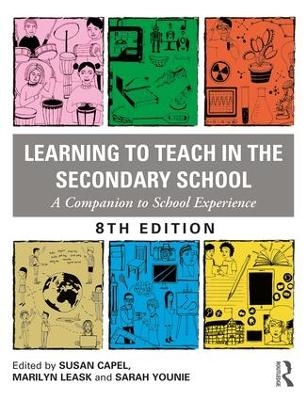
Learning To Teach In The Secondary School
Routledge (Verlag)
978-1-138-30759-9 (ISBN)
- Titel erscheint in neuer Auflage
- Artikel merken
The text includes a wealth of examples and tasks to demonstrate how to successfully apply theory to practice and how to critically reflect on and analyse your practice to maximise pupil learning. The wide range of pedagogical features supports both school- and university-based work up to Masters level. Written by experts in the field, the 37 concise units create unit-by-unit coverage that can be dipped into, offering guidance on all aspects of learning to teach including:
Managing your workload
Lesson planning
Curriculum
Motivating pupils
Promoting behaviour for learning
Assessment, marking and feedback
Special educational needs and disabilities (SEND)
Applying for jobs, developing as a professional and networking
Learning to Teach in the Secondary School provides practical help and guidance for many of the situations and potential challenges you are faced with in school. The text is extended by a companion website that includes additional information as well as specific units covering England, Northern Ireland, Scotland and Wales. Supported by the subject-specific titles in the Learning to Teach Subjects in the Secondary School Series, it is an essential purchase for every aspiring secondary school teacher.
Susan Capel is an Emeritus Professor (Physical Education) at Brunel University, UK. Marilyn Leask is Chief Editor of the MESHGUides initiative (www.meshguides.org) and visiting professor at the University of Winchester and De Montfort University, UK. Sarah Younie is Professor of Education Innovation at De Montfort University, UK, and Chair of the Education Futures Collaboration charity.
List of illustrations
List of tasks
List of contributors
Acknowledgements
Introduction to the 8th Edition
Unit 1 BECOMING A TEACHER
1.1 Becoming a teacher: What do teachers do?
Linda la Velle and Marilyn Leask
1.2 Student teachers’ roles and responsibilities
Susan Capel
1.3 Developing your resilience: Managing stress, workload and time
Maddy Findon and Sue Johnston-Wilder
1.4 Using digital technologies for professional purposes
Andrew Csizmadia and Sarah Younie
Unit 2 BEGINNING TO TEACH
2.1 Reading classrooms: How to maximise learning from classroom observation
Ava Redondo
2.2 Schemes of work, units of work and lesson planning
Sophy Bassett, Mark Bowler and Angela Newton
2.3 Taking responsibility for the whole class
Michelle Lowe and Clyde Redfern
Unit 3 CLASSROOM INTERACTIONS AND MANAGING PUPILS
3.1 Communicating with pupils
Paula Zwozdiak-Myers and Susan Capel
3.2 Motivating pupils
Misia Gervis and Susan Capel
3.3 Managing classroom behaviour: Adopting a positive approach
Philip Garner
3.4 Primary-secondary transitions
Divya Jindal-Snape
Unit 4 MEETING INDIVIDUAL DIFFERENCES
4.1 Pupil grouping, progression and differentiation
Alexandra Titchmarsh
4.2 Adolescence, health and well-being
Ceri Magill and Barbara Walsh
4.3 Cognitive development
Judy Ireson and Paul Davies
4.4 Responding to diversity
Helen Bowhay and Stefanie Sullivan
4.5 Values education: Discussion and deliberation
Ruth Heilbronn
4.6 An introduction to inclusion, special educational needs and disability
Nick Peacey
Unit 5 HELPING PUPILS LEARN
5.1 Ways pupils learn
Diana Burton
5.2 Active learning
Michelle Lowe
5.3 Teaching styles
Chris Carpenter and Hazel Bryan
5.4 Improving your teaching: An introduction to practitioner research, reflective practice and evidence-informed practice
Marilyn Leask and Tony Liversidge
5.5 Closing the achievement gap: Self-regulation and personalising learning
Carrie Winstanley
5.6 Neuroeducation: Classroom practice and the brain
Paul Howard-Jones
5.7 Developing critical thinking
Hazel Bryan and Chris Carpenter
5.8 Creating a language-rich classroom
Annabel Watson and Debra Myhill
Unit 6 ASSESSMENT
6.1 In-school summative and minute-by-minute formative assessment in the classroom
Nikki Booth
6.2 External assessment and examinations
Cara McLaughlin
6.3 Using feedback and data effectively to move teaching and learning forward
Nikki Booth
Unit 7 THE SCHOOL, CURICULUM AND SOCIETY
7.1 Aims of education
Ruth Heilbronn, Janet Orchard and Graham Haydon
7.2 The secondary school curriculum
Shirley Lawes
7.3 Secondary schools in England: Governance, policy and curriculum
Shirley Lawes
7.4 Secondary schools in Northern Ireland: Governance, policy and curriculum
Paul McFlynn and Paul McQueen
7.5 Secondary schools in Scotland: Governance, policy and curriculum
Anna Beck
7.6 Secondary schools in Wales: Governance, policy and curriculum
Susan Lewis, David Grace and Susan Capel
Unit 8 YOUR PROFESSIONAL DEVELOPMENT
8.1 Getting your first post
Julia Lawrence and Susan Capel
8.2 Developing further as a teacher
Jeanne Keay
8.3 Accountability
Leora Cruddas
8.4 Developing as a professional
Caroline Daly and Clare Brooks
Unit 9 AND FINALLY
9.1 And finally
Marilyn Leask
Appendix 1
Appendix 2
Appendix 3
Appendix 4
References
Author index
Subject index
| Erscheinungsdatum | 02.05.2019 |
|---|---|
| Reihe/Serie | Learning to Teach Subjects in the Secondary School Series |
| Verlagsort | London |
| Sprache | englisch |
| Maße | 189 x 246 mm |
| Gewicht | 1487 g |
| Themenwelt | Sozialwissenschaften ► Pädagogik ► Schulpädagogik / Sekundarstufe I+II |
| ISBN-10 | 1-138-30759-9 / 1138307599 |
| ISBN-13 | 978-1-138-30759-9 / 9781138307599 |
| Zustand | Neuware |
| Informationen gemäß Produktsicherheitsverordnung (GPSR) | |
| Haben Sie eine Frage zum Produkt? |
aus dem Bereich



